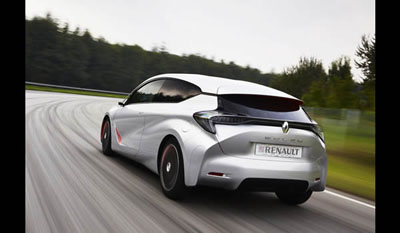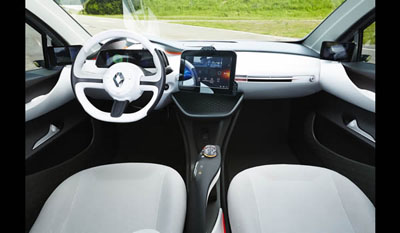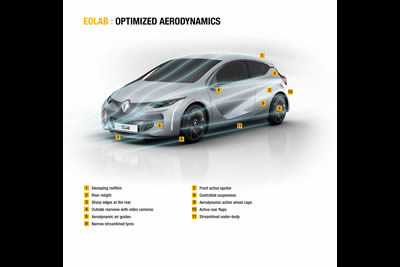Renault EOLAB 1 Litre per 100 km (235 mpg) PHEV Concept 2015
Renault presents EOLAB, a new prototype which explores ways to deliver ultra-low fuel consumption. It boasts NEDC combined cycle consumption* of 1 litre/100km (235 mpg U.S.), equivalent to 22g of CO2/km. To achieve such low figures, the designers focused their efforts on three main areas: minimising weight, refining aerodynamics and using “Z.E. Hybrid” technology for all, a brand new initiative which permits zero emissions* motoring during everyday use. As an innovative showcase with an environmental core, the Renault EOLAB includes a very high number of technological advances that are destined to be carried over gradually to vehicles available in the showroom. As a consequence, the Renault EOLAB underlines the undertaking of Renault – already a pioneer in the field of zero-emission mobility** thanks to its range of electric vehicles – to take even greater steps to produce affordable models that have an increasingly smaller carbon footprint.
* Fuel consumption, emissions and range data homologated in accordance with appropriate legislation. ** No CO2 or other regulated polluting emissions during road use.
Technologies geared to achieving ultra-low fuel consumption for all
For Renault, the purpose of the Renault EOLAB is to remain true to the company’s DNA by ensuring that ultra-low fuel consumption becomes a reality for as many people as possible. This in turn means making its technologies available at a price that people can afford. The Renault EOLAB features materials such as magnesium and aluminium, which are extremely light and also much cheaper than titanium. Meanwhile, the notion of such a car being produced in large numbers within the next 10 years was computed into the plan from the very start.
The Renault EOLAB is much more than just a styling exercise or a mere shop window. Conceived around a B-segment platform, the prototype incorporates around 100 new, realistic technological developments that are designed to be introduced gradually on upcoming Renault vehicles.
Renault EOLAB’s recipe
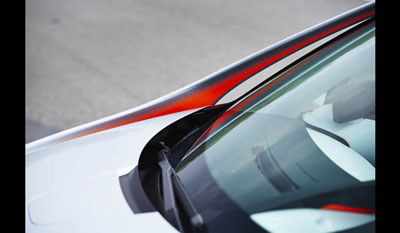 |
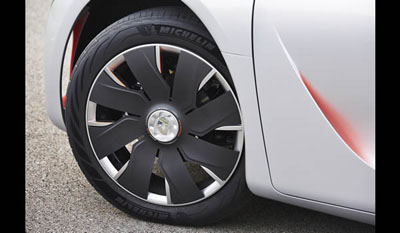 |
The Renault EOLAB prototype’s exceptional fuel economy – namely 1 litre/100km – is the fruit of work on three main fronts: refined aerodynamics, weight saving and Z.E. Hybrid technology (petrol/electricity): - The car’s shape was designed to slice through air efficiently, while movable devices such as an active spoiler and lateral vanes perform the same way as ailerons. - A weight saving programme brought the car’s mass down by just 400kg, thanks in particular to a multi- material body shell combining steel, aluminium and composites, as well as a remarkable magnesium roof that tips the scales at barely 4kg. Saving weight was a virtuous circle since it enabled the size, and therefore the cost of the prototype’s chief assemblies (engine, battery, wheels, brakes, etc.) to be kept low, thereby financing the decision to employ certain more costly materials; - Z.E. Hybrid technology: this new, compact and affordable hybrid power unit combines ultra-low fuel consumption with zero-emission mobility* for journeys of less than 60km and at speeds of up to 120kph. In coming years, Z.E. Hybrid technology will become complementary to Renault’s zero-emission* electric vehicle range.
A contribution to the French government’s ‘New Industrial Plan EOLAB forms part of the ‘fuel consumption of 2 litres/100km for all’ plan introduced within the framework of France’s so-called New Industrial Plan. However, EOLAB goes further than the fuel consumption target set by the French government since it sets its sights on the much longer term. In the course of the prototype’s design, Renault developed the technologies necessary for the introduction of a car with fuel consumption of just 2 litres/100km by 2020. To achieve this, Renault worked in a spirit of collaborative innovation with French automotive industry partners like car glass manufacturer Saint-Gobain, seat supplier Faurecia, tyre company Michelin and Continental (brake system). Renault also worked closely with major partners like the Korean company Posco (magnesium components). The specific know-how of all these partners made a valuable contribution to the success of the EOLAB prototype.
EOLAB Concept: a concept car to capture the imagination Renault’s designers were closely involved with the EOLAB project from its very early days. In the case of EOLAB Concept, they pushed the design parameters to perfect the car’s styling and paid significant attention to detail in order to optimise aerodynamics and weight. With its sloping roof and breathtakingly slender rear end, the concept car’s true purpose is well masked: beneath its seductively designed shell, everything is geared towards frugality. It demonstrates that Renault is able to add a touch of dream-like magic to a prototype whose fundamental mission is to achieve ultra-low fuel consumption.
 |
PHEV (Plug-in Hybrid Electric Vehicle) -Z.E. HYBRID: HYBRID TECHNOLOGY FOR ALL
In addition to being lightweight and aerodynamically efficient, the Renault EOLAB demonstration car goes even further in its bid to achieve ultra-low fuel consumption thanks to its 100%-Renault hybrid powertrain which is covered by more than 30 patents. This technology consists in combining a petrol internal combustion engine (ICE) with a compact electric motor. This solution permits 60km (37 miles)** of zero emission* motoring plus extended range thanks to the internal combustion engine. Importantly, it can be carried over to entry-level vehicles which are by definition a more affordable reality for a higher number of motorists. This technology will be incorporated in the range by 2020.
In the case of the EOLAB prototype, the ICE part of the powertrain takes the form of a small three-cylinder 999cc petrol engine with a power output of 57kW (75hp) and peak torque of 95Nm. It is mated to a highly innovative clutch-less transmission based on a compact and economical three-speed gearbox which is sufficient to cover the vehicle’s speed range. This is a notable advantage compared with the majority of the market’s hybrid technologies which make use of CVT- or DCT-type transmissions (Continuous Variable Transmission, or Dual Clutch Transmission). These tend to be bulky, heavy and costly, and consequently ill-suited to small cars. The chief feature of the concept lies in the clutch casing which houses a permanent magnet electric motor (axial flux discoid motor in the case of the prototype). This motor is compact and economical and covers the need for the availability of extra torque since it is capable of instantly delivering peak power of 50kW and 200Nm of torque.
Fed by a 6.7kWh battery, it is sufficiently big to power the car under electrical power. Here again, the war waged on the weight of the body shell made a great deal of sense inasmuch as a
lighter car needs less energy to be moved forward. As a consequence, the battery can be both smaller and less expensive.
It is important to note that the first two ratios of the three-speed gearbox are mated to the electric motor, while the third ratio is linked to the ICE. These three ratios permit nine different combinations for the electric and hybrid modes combined. One of the concept’s major innovations is the fact that gearshifts do not necessitate the use of a clutch thanks to a specific control unit designed by Renault’s engineers.
The Renault EOLAB’s axial flux permanent magnet electric motor is powered by a 6.7kWh lithium-ion battery which differs from the batteries that equip Renault’s Z.E. range of electric vehicles. While electric vehicles are designed to store a high amount of energy because of the fundamental need to maximise the vehicle’s range, hybrid vehicles like EOLAB need to cover the same power requirement with a limited quantity of electrical energy. This entails using a different type of battery cell with a higher power/energy ratio. The resulting battery pack is the fruit of active cooperation between the teams at Renault and the CEA who rose to the challenge of finding smart solutions to come up with a battery pack that is capable of storing a high amount of energy in a smaller volume, while at the same time minimising weight.
Z.E. Hybrid… One mode for weekday use, another for weekends
A choice of two modes. - The ‘weekday’ mode favours the use of electrical power for everyday journeys (e.g. from the home to the workplace) in order to get as close to zero tailpipe emissions* and zero fuel consumption* as possible. The Renault EOLAB’s range is sufficient to cover 60km* under electrical power. When this mode is selected, the car always pulls away under electrical power and the first gear allows speeds of up to 60/70kph to be reached. At faster speeds, the system automatically engages the second gear and continues to run on electricity alone up to 120kph. Beyond this speed, the hybrid system automatically calls on the internal combustion engine which drives through the third gear. - The ‘weekend’ mode combines both sources of power to permit longer travelling distances. Although the car still pulls away under electrical power, the internal combustion engine is engaged at a lower speed. The two power sources then combine, not only to use less energy but also to benefit from a real power boost thanks to the association of the ICE’s 57kW (75hp) and the electric motor’s 40kW. In this mode, the battery charges under deceleration and braking (range saver function). The combination of the different gear ratios covers use up to the vehicle’s top speed in hybrid mode. This is a major concept that shows a way forward for hybridisation. "Today, most of the market’s hybrid vehicles are higher segment cars with a price tag of more than €40,000. The solutions showcased by the Renault EOLAB are much more economical and enable hybrid technology to be used for smaller cars and on a much bigger scale. Our objective is to produce a car with two power sources for the price of one,” underlines Jean-Pierre Fouquet, Z.E. Hybrid Innovation Project Leader.
Different countries’ energy supplies and contrasting usage patterns are pushing manufacturers to expand their ranges and diversify according to local market conditions. As part of the Renault-Nissan Alliance, the Renault group intends to maintain its status as a worldwide market leader in the field of electric vehicles. PHEV (plug-in hybrid electric vehicle) solutions, such as that featured on EOLAB, complement this range and will be developed to suit widely differing driving patterns… but always with the goal of covering significant distances with “zero emissions”*. * No CO2 or other regulated polluting emissions during road use.
WEIGHT SAVING
The Renault EOLAB tips the scales at 955kg (2.105 lb.). That’s more than 20 percent lighter than the benchmark vehicle. Total weight savings amounted to no less than 400kg (882 lb.) thanks to the teams’ holistic approach. This ambitious programme called for extensive work and outside-of-the-box thinking from the different specialists involved.
The virtuous circle of shedding weight While delivering the same level of performance, lighter vehicles require less energy to move forward. One of the chief focuses in the case of the EOLAB project consequently consisted in reducing the vehicle’s overall weight. This in turn meant that the vehicle’s principle assemblies (powertrain, brakes, running gear, cooling system, fuel tank, etc.) could also be lighter, and these additional savings compounded the initial groundwork.
“The savings achieved by taking a fresh look at the size of the different mechanical assemblies enabled us to cover the cost of using more expensive materials and technologies elsewhere without losing sight of the aim not to add to the overall cost.” Laurent Taupin (EOLAB Project Leader).
OPTIMIZED AERODYNAMICS COMBINED WITH ACTIVE SYSTEMS
Drag coefficient (CdA) reduced by 30 percent EOLAB’s CdA is 0.470m2 (A = 2.00m2 / Cd = 0.235) which represents an overall reduction of 0.200m² (around 30 percent). This lower drag coefficient results in a significant fuel consumption reduction at higher speeds. At a stable speed of 130kph (81 mph), for example, it accounts for a fuel consumption saving of 1.2 litres/100km (196 mpg U.S.) in comparison with the benchmark vehicle.
This exceptional aerodynamic efficiency was achieved by combining several factors: - Ground-breaking vehicle architecture, an innovative approach which includes a narrower rear track and a lower roofline without detracting from cabin space. - Carefully designed rear body panels. - Incorporation of active systems for even greater aerodynamic efficiency.
NOTE: the measure of a vehicle’s overall aerodynamic efficiency is its CdA, i.e. the vehicle’s frontal section (A) expressed in square metres multiplied by its drag coefficient (Cd). The CdA of the Clio IV, for example, is 0.670m², which is a good average for its segment. However, CdA gains should not be achieved to the detriment of design considerations or other characteristics, such as cabin space.
Active wheels
The teams that worked on the Renault EOLAB took a close look at its wheels, too. In a perfect aerodynamic world, the rims would be covered and smooth. This is rarely the case, however, essentially for design- and brake cooling-related reasons. An ingenious system was consequently designed whereby the rims are covered whenever the brakes do not need to be cooled, thereby reconciling design and aerodynamic efficiency considerations. The system is controlled by a temperature sensor built into the rims.
Tyres designed for aerodynamics designed by Michelin To further perfect the Renault EOLAB’s aerodynamic performance, it is fitted with particularly narrow, 145mm-wide tyres. That’s 40mm narrower than the smallest tyres available for the Clio IV. Michelin and Renault’s designers worked on the tread pattern to give a visual impression of width, while the sidewalls were designed to exude an impression of light weight. At the same time, tyre supplier Michelin optimised the casing and tread to minimise rolling resistance while maintaining excellent levels of safety and performance. The tyres’ rolling resistance is 15 percent lower than those of the Clio IV which itself is quite strong in this area. These tyres are also lighter, and their profile has been honed to minimise drag. Meanwhile, Renault has changed the technology used for the wheel bearings in favour of a more efficient solution that has achieved a CO2 emissions saving of 1g/km.
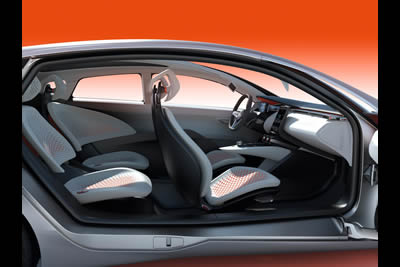 |
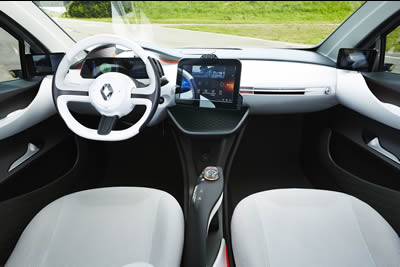 |
INTERIOR DESIGN: A COCOON
The interior features a dashboard of flowing lines, a link in perfect harmony with the door panels. The curved form of the electronic instrument display adds to the overall sense of lightness. A polished aluminium panel underlines the theme of the dashboard and extends outside the car as a support for the rearview cameras. It also conceals a indirect air circulation system inside the cabin.
The rearview mirrors are replaced by screens integrated with the windscreen pillars. The speedometer is built into a curved OLED (Organic Light-Emitting Diode) screen, with excellent definition and brightness. In the center of the dashboard is a vast vertical screen with an exclusive R-Link interface. This platform delivers the first user experience specially developed for cars, based on an open Android platform equivalent to that of consumer smartphones and tablets. The car becomes a mobile medium in which drivers can buy, find and synchronize all the apps generally installed on a computer, tablet or smartphone. In addition to navigation functions and connected services, the system features a series of screens specially designed for cars with, for example, a radar diagram with a real-time display of the main factors influencing fuel consumption (rolling resistance, gradient, air conditioning/heating, aerodynamics/braking), in order to help drivers perfect their eco-driving performance.
Visual lightness and sophistication A floating central console contributes to the overall impression of lightness, as do the slender seats mounted on central rails to provide better accessibility and more leg room at the rear. The four individual seats are real cocoons with, at the rear a side trim piece for an even greater impression of comfort. The seats are upholstered in perforated leather with a 3D pattern reflecting the “haute couture” aspect of the Renault EOLAB Concept and contrast stitching in fluorescent orange as on the bodywork. This pattern resembles the “pixelated” appearance of the front bumper, while also expressing the lightness of the concept. The same pattern can be seen in relief on the dashboard and side panels.
The interior characteristics of the Renault EOLAB Concept make it highly realistic, a definition expressed from a different visual perspective by the Renault EOLAB prototype, a car ready to take to the road and to demonstrate all the qualities of this ultra- low consumption vehicle.
 |
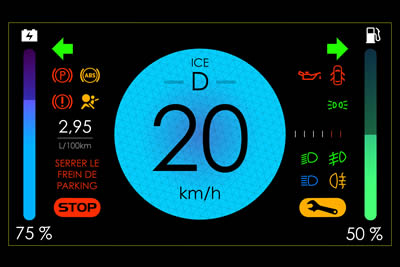 |
REAL-TIME INFORMATION CONTRIBUTING TO ULTRA-LOW FUEL CONSUMPTION
HMIs in favour of low fuel consumption and motoring enjoyment
Although Renault’s first hybrid vehicle – EOLAB – is packed with technologies and innovations, it is still aimed at the brand’s core customers, so had to remain easy to use and intuitive. At the same time, its Human Machine Interfaces (HMI) go even further down the road of providing information in real time with a view to helping drivers to benefit from ultra-low fuel consumption.
Its development was guided by three factors: - Visualisation of the Renault EOLAB’s technological features: the Renault EOLAB demonstration car is equipped with aerodynamic features like an active front spoiler and active flaps which deploy at speeds in excess of 70kph. - Intuitive: despite the car’s advanced technological content, the MMI was designed to be simple to use. "When a car targets a broad public, it is important that its use is easy to take on-board without having to read a manual that is dozens of pages long. In this respect, EOLAB follows the example set by R-Link which has received numerous accolades for its intuitive ease of use.” -
PERFORMANCE AND OWNERSHIP COSTS SIMILAR TO THOSE OF A CLIO-TYPE VEHICLE
Weight reduction, aerodynamic efficiency and hybridisation were three key themes that were explored with a common objective – that of developing realistic solutions that are transferable to mass-production cars. “Beyond the prototype, we need to make advances across the entire range,” affirms Project Leader Laurent Taupin. Similarly important to note is the fact that the lower fuel consumption figures have been achieved without impacting the vehicle’s performance in any way: “However efficient and economical it is, the vehicle must also remain competitive in every area if it is to attract buyers. This includes comfort, road holding, cabin space, perceived quality and design.”
In addition to the fact that it is based on a B-segment saloon, EOLAB was developed using a realistic technological and economic approach with a twofold objective: - To offer the same level of performance as a current vehicle. - To be able to gradually carry the technological solutions spawned by EOLAB across to future Renault.
KEEPING COST UNDER CONTROL
When it comes to reducing weight, there is always the option of resorting to lightweight materials such as titanium, carbon-fibre or other composites, but in view of their expense, their wide-scale use would inevitably raise the price of the car. Such a scenario would be contrary to Renault’s very ethos, which is to make its cars available to the highest possible number of customers. What’s more, a very lightweight and expensive vehicle would remain something of a niche in commercial terms and, as such, would not generate any real benefits for the environment. EOLAB was developed with the target of producing a level of performance and price tag representative of a B- segment vehicle. The EOLAB project team thus paid careful attention to the key parameter of cost.
Related Articles :
Wallpapers of the Renault EOLAB 1 Litre per 100 km (235 mpg) PHEV Concept 2015 (click on image to enlarge)









